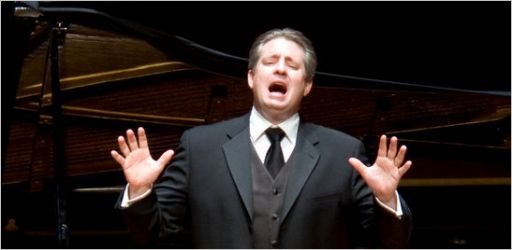Atlanta, Georgia, Spivey Hall, Clayton State University
Tenor Matthew Polenzani
Piano Julius Drake
Ludwig van Beethoven: Alelaide, Op. 46
Franz Lizst: Der Glückliche, K. 334; Wie singt die Lerche schön K.312; Die stille Wasserrose K.221; Im Rhein, im schönen Strome, K.272; Es rauschen die Winde K.294 – Four Songs on Poems by Victor Hugo: S’il est un charmant gazon, K. 284; Enfant, si j’étais roi, K. 283; Comment, disaient-ils, K. 276; Oh! quand je dors, K. 282.
Erik Satie: 3 Mélodies: La statue de bronze; Daphénéo; Le chapelier.
Maurice Ravel: Cinq mélodies populaires grecques: Chanson de la mariée; Là-bas, vers l’église; Quel galant m’est comparable; Chanson des cueilleuses de lentisques; Tout gai!
Samuel Barber: Hermit Songs, Op. 29: At St. Patrick’s Purgatory; Church Bell at Night; St. Ita’s Vision; The Heavenly Banquet; The Crucifixion; Sea Snatch; Promiscuity; The Monk and his Cat; The Praises of God; The Desire for Hermitage.
Atlanta, January 17, 2015
Vocal recitals can be difficult to sell tickets for without a recognised singer, but most “name” classical singers perform primarily on operatic stages and are not at home with a wide range of song and recital repertoire. Two and three generations ago European singers like Fischer-Diskau, Prey, Wunderlich and Björling regularly performed a wide range of song literature, and Thomas Hampson more recently made recital an integral part of his profile. So it is a special event when a new operatic talent, especially a tenor fills the current void and brings a high level of musicality and vocal accomplishment to a grateful audience outside the usual musical centers. Spivey Hall in Atlanta, Georgia has made a specialty of this over the past twenty years Despite the ravages wreaked by the 2008 financial crisis on American classical music, especially opera, they have continued and on Saturday afternoon gave the music lovers of the Atlanta area a concert which brought Liszt lovers close to tears and showcased a tenor whose musicality, vocal technique and resources are matched by his operatic achievements in roles such as Les contes d’Hoffmann, Manon, L’Elisir d’amore and La Traviata on stages including the Metropolitan Opera, Covent Garden and Munich.
Matthew Polenzani sang a program with his superb collaborator, the pianist Julius Drake, featuring Liszt Songs in German and French, Satie, Ravel and ended with the American Samuel Barbar’s Hermit Songs. The Liszt in particular showed the pianist and singer to best advantage, emphasising musicality, bravura pianistic display, strong and pitch perfect singing as well as very effective use of fila di voce in the upper register. Polenzani has an instinct for the important moments, and despite his somewhat homogenous French, ended the Liszt French group and the first half of the concert with a gorgeous sustained pianissimo. Satie 3 Mélodies began the second half of the afternoon recital. They are more musically accessible than most of his oeuvre and although they lie low in the vocal register the declamatory nature of the French better suited Polenzani’s delivery of the language. In contrast Ravel’s Cinque mélodies populaires grecques was his weakest group because of the very particular linguistic vocalism necessary to bring Ravel’s music to life Ravel’s settings demands that the voice react to the language for color and expression while Polenzani seems to place the language within his vocal technique. The group nonetheless charming and lighthearted, highlighting Polenzani’s sympathetic stage presence. The Samuel Barber is one of the standard major cycles in modern American song literature. Consisting of ten songs translated into English from ancient Irish monks it premiered in 1953 with Leontyne Price and Barber himself at the piano. Polenzani and Drake presented a strong, clear and elegant version of a classic of self conscious American musical modernism. While not compelling it was superbly executed.
The concert was all the more remarkable because as well as he sang, Polenzani often seemed to be accompanying the pianist. Julias Drake displayed a mastery of sound, texture, dynamic and spot on virtuosity that was breathtaking. Polenzani knew when his moments were and made the most of them. Drake made his own moments with stunning pianissimo tones and a flowing sound rarely heard from any instrument. Liszt’s piano writing of course provided ample opportunity for powerful bravura which Drake delivered with verve strength and accuracy. There may have been a few places early on where he did not breathe with his singer, but Julius Drake is truly more than an accompanist for the highest rank of singer. In the United States today the term “collaborative pianist” has come to replace “accompanist” in many institutions. Julius Drake brought this new term to a new level. Photo Bryan Harkin
